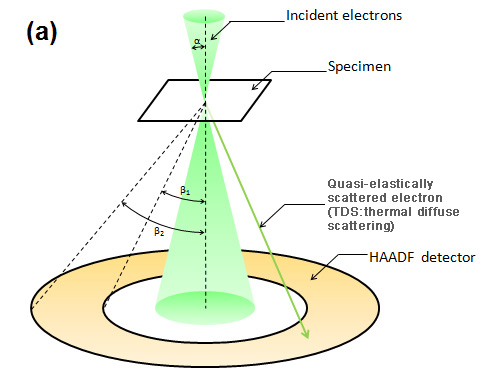高角度散乱暗視野(走査透過電子顕微鏡)法
高角度散乱暗視野(走査透過電子顕微鏡)法
high-angle annular dark-field scanning transmission electron microscopy, HAADF-STEM
[目次:理論(電子の散乱/回折/結像)]
走査透過電子顕微鏡法(STEM) の円環状検出器による暗視野法(ADF)のうち、格子振動による熱散漫散乱によって高角度に非弾性散乱された電子を円環状の検出器(~50−十分高角:たとえば200mrad)で受け、この電子の積分強度を入射電子プローブの位置に対応させて表示してSTEM像を得る手法。像強度は原子番号の1.4~2乗に比例するとされているので、重い原子がより明るく観察され、軽い原子は見えにくい。高角度に散乱された電子を使うので散乱断面積が小さく多重散乱がないこと、および電子波の干渉効果が結像に関与していない(非干渉像)ため、像の解釈が容易である。分解能は試料上の入射ビームのサイズでほぼ決まり、最高性能の装置では0.05nmを切っている。円環状検出器の中心を通り抜けた電子を使ったEELSとの併用により、原子コラムごとの元素分析ができる。一方、軽元素を効果的に可視化するSTEMとして、環状明視野法(ABF-STEM)、低角度散乱暗視野法(LAADF-STEM)という方法もある。
HAADF-STEM ⇒図
図(a) HAADF-STEMにおける入射電子線の収束角と散乱電子線の検出器への取り込み角の関係。検出器の典型的な取り込み角はβ1 ~ 50 mrad,β2 ~ 200 mradである。高角度に散乱された非弾性散乱電子を検出する。200 kVの収差補正電子顕微鏡の場合、αは25 mrad程度である。通常、ABF検出器やLAADF検出器はHAADF検出器の下部に配置される。
High-angle annular dark-field scanning transmission electron microscopy (HAADF-STEM) is a STEM method which receives quasielastically scattered electrons, that is thermal diffuse scattering (TDS) at high angles using an annular dark-field (ADF) detector (~50 to sufficiently high angle; e.g. ~200 mrad). A STEM image is acquired by displaying the integrated intensities of the electrons in synchronism with the incident probe position. As the HAADF image intensity is reported to be proportional to 1.4 square to a square of the atomic number, heavy atoms are observed brighter, but light atoms are difficult to be observed. The HAADF image is easily interpreted due mainly to two reasons.
1) No multiple scattering arises because the scattering cross section of TDS at high angles used for the imaging is small.
2) The interference effect of electrons does not take place for the imaging (non-interference image).
The resolution of the HAADF image is almost determined by the incident probe diameter on the specimen. A high-performance STEM instrument provides a resolution better than 0.05 nm. A combined use with EELS, which uses electrons transmitted through the center hole of the ADF detector, enables element analysis column by column. Nowadays, the annular bright-field (ABF) STEM and the low-angle annular dark-field (LAADF) STEM are utilized as STEM methods to effectively visualize light atoms.

Fig.(a) Relationship between the convergence semi-angle of the incident electron beam and acceptance semi-angles of the detector for HAADF-STEM. Typical inner and outer semi-angles of the detector are respectively β1 = ~50 mrad and β2 = ~200 mrad, detecting quasielastically scattered electrons at high angles. The value of the convergence semi-angle α is approximately 25 mrad for a 200 kV Cs-corrected TEM. Usually, an ABF detector and a LAADF detector are placed below a HAADF detector.
関連用語から探す
説明に「高角度散乱暗視野(走査透過電子顕微鏡)法」が含まれている用語






